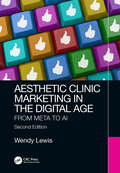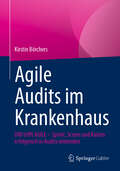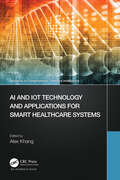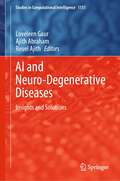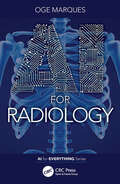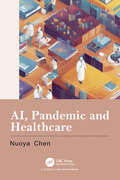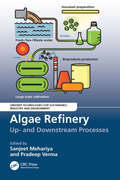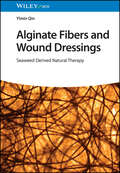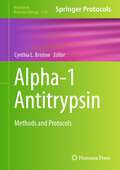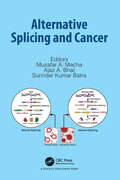- Table View
- List View
Aesthetic Clinic Marketing in the Digital Age: From Meta to AI
by Wendy LewisAesthetic practitioners and medical spas have flourished, and global statistics indicate that consumer engagement is at an all-time high. The rise of social media provides new ways to connect with consumers and differentiate clinics that stand out in the marketplace. For busy clinic managers and practitioners, keeping up with the nuances of digital media trends is practically a full-time job. With over 25 years of experience in medical aesthetics, Wendy Lewis shares her deep understanding of the challenges aesthetic practitioners face to effectively market their products and services, manage patients, and increase profits. This updated text is the definitive expert user’s guide written specifically for healthcare professionals and medical spa managers to present best practices and actionable strategies for mastering digital marketing, social media, branding, and the advent of AI. It is a must-read for aesthetic practitioners to keep up with the latest developments they need to manage their businesses effectively in this highly competitive field.This second edition features: NEW chapters on hot topics you need to know MORE tips, charts, tables, and resources UP-TO-THE-MINUTE strategies for success
Aesthetic Gynecology Rejuvenation
Aesthetic Gynecology is a fast-growing market amid much new demand from patients since gynecological defects can have considerable impact on their quality of life. This fully illustrated text provides an authoritative guide from international experts on the anatomical, functional, and medical aspects, details the surgical treatments, and documents the clinical and procedural points arising.
Aesthetic Gynecology Rejuvenation
by Alexander BaderAesthetic Gynecology is a fast-growing market amid much new demand from patients since gynecological defects can have considerable impact on their quality of life. This fully illustrated text provides an authoritative guide from international experts on the anatomical, functional, and medical aspects, details the surgical treatments, and documents the clinical and procedural points arising.
Aesthetic Procedures: Nurse Practitioner's Guide to Cosmetic Dermatology
by Beth HaneyThis second edition is a resource that offers guidance to advanced practice providers who are experienced or novice aesthetic practitioners and would like to improve their aesthetic practice and enhance patient safety and satisfaction. This new book reviews skin structure and anatomy, what happens as facial structures age, the effects of aging coupled with environmental exposures, pharmacology of medications used in aesthetics, light-based device properties, patient selection, danger zones, complications, new treatments, and benefits of treatments. In addition, it includes suggestions on how to communicate with patients to achieve successful outcomes. Aesthetic Procedures: Nurse Practitioner's Guide to Cosmetic Dermatology provides practitioners a one-source resource to attain more in-depth learning about cosmetic dermatology. Although there are several texts on individual aspects of aesthetic medicine, there is no all-inclusive book for advanced practice providers. This book also affords the primary care practitioner the opportunity to add minimally invasive cosmetic dermatology procedures to their practice and perform the treatments safely, efficiently and effectively while avoiding common mistakes and minimizing complication risks. Education and hands-on practice and training are paramount in creating a safe patient environment and as more clinicians turn to aesthetics to augment their practice, this book will be a valuable resource for practitioners all over the world.
Agile Audits im Krankenhaus: DIN trifft AGILE - Sprint, Scrum und Kaizen erfolgreich in Audits einbinden
by Kirstin BörchersAudits im Krankenhaus werden oft noch sehr dokumentenlastig und auf ISO-Konformitätsprüfung ausgerichtet durchgeführt. Dabei geht es in Zeiten von E-Health, Digitalisierung und künstlicher Intelligenz (KI) im Krankenhaus längst um mehr und es ist vor allem eine flexiblere Herangehensweise gefordert. Die aktuellen Transformationsprozesse benötigen schnellere und dynamischere Anpassungen in der Organisation und bei den Abläufen. Mit Hilfe von agilen Audit-Instrumenten wie Scrum, Kaizen und Kanban können diese Herausforderungen gemeistert werden.Dieses Buch stellt nach einer Einführung in die Grundlagen von Audits die wichtigsten agilen Werte, Praktiken und Methoden vor, erläutert ihren möglichen Einsatz im Rahmen des allgemeinen Auditprozesses wie auch in den sogenannten „Audits im Sprint“. Agilität im Qualitätsmanagement und in der Durchführung interner Audits steht nicht im Widerspruch zum Leitfaden ISO 19011 „Auditierung von Managementsystemen“, in dem es um dieWirksamkeit und Eignung des QM-Systems sowie dessen Chancen zur Weiterentwicklung geht – sie ist vielmehr eine konsequente Weiterentwicklung. Best-Practice-Beispiele veranschaulichen, wie eine konkrete Umsetzung im Krankenhausumfeld aussehen kann.
AI and IoT Technology and Applications for Smart Healthcare Systems (Advances in Computational Collective Intelligence)
In recent years, the application of Artificial Intelligence (AI) and Internet of Things (IoT) technologies in smart healthcare has been increasing. We are approaching a world where connected smart devices tell people when they need to visit a doctor because these devices will be able to detect health problems and discover symptoms of illness that may need medical care. AI-collaborative IoT technologies can help medical professionals with decision-making. These technologies can also help develop a sustainable and smart healthcare system.AI and IoT Technology and Applications for Smart Healthcare Systems helps readers understand complex scientific topics in a simple and accessible way. It introduces the world of AI-collaborative IoT physics, explaining how this technology behaves at the smallest level and how this can revolutionize healthcare. The book shows how IoT technology and AI can work together to make computers more powerful and capable of solving complex problems in the healthcare sector. Exploring the effect of AI-collaborative technology on IoT technologies, the book discusses how IoT can benefit from AI algorithms to enable machines to learn, make decisions, and process information more efficiently. Because smart machines create more perceptive devices and systems, the application of this technology raises important ethical questions about privacy, security, and the responsible development of healthcare IoT technology, which this book covers. The book also provides insight into the potential applications of these technologies not only in the healthcare industry but also in related fields, such as smart transportation, smart manufacturing, and smart cities.
AI and IoT Technology and Applications for Smart Healthcare Systems (Advances in Computational Collective Intelligence)
by Alex KhangIn recent years, the application of Artificial Intelligence (AI) and Internet of Things (IoT) technologies in smart healthcare has been increasing. We are approaching a world where connected smart devices tell people when they need to visit a doctor because these devices will be able to detect health problems and discover symptoms of illness that may need medical care. AI-collaborative IoT technologies can help medical professionals with decision-making. These technologies can also help develop a sustainable and smart healthcare system.AI and IoT Technology and Applications for Smart Healthcare Systems helps readers understand complex scientific topics in a simple and accessible way. It introduces the world of AI-collaborative IoT physics, explaining how this technology behaves at the smallest level and how this can revolutionize healthcare. The book shows how IoT technology and AI can work together to make computers more powerful and capable of solving complex problems in the healthcare sector. Exploring the effect of AI-collaborative technology on IoT technologies, the book discusses how IoT can benefit from AI algorithms to enable machines to learn, make decisions, and process information more efficiently. Because smart machines create more perceptive devices and systems, the application of this technology raises important ethical questions about privacy, security, and the responsible development of healthcare IoT technology, which this book covers. The book also provides insight into the potential applications of these technologies not only in the healthcare industry but also in related fields, such as smart transportation, smart manufacturing, and smart cities.
AI and Neuro-Degenerative Diseases: Insights and Solutions (Studies in Computational Intelligence #1131)
by Loveleen Gaur Ajith Abraham Reuel AjithThis book explores the current state of healthcare practice and provides a roadmap for harnessing artificial intelligence (AI) and other modern cognitive technologies for neurogenerative diseases. The main goal of this book is to look at how these techniques can be used to classify patients with neurodegenerative diseases by extracting data from multiple modalities. It demonstrates that the growing development of computer-aided diagnosis systems has a lot of potential to help with the diagnostic process. It offers an analysis of the prospective and perils in implementing such state of the art.Progressive brain disorders with a high prevalence in the general population include Parkinson's disease, Alzheimer's disease and other types of dementia, Huntington's disease, and motor neuron disease. Worldwide, it is estimated that 33 million people have Alzheimer's disease, and 10 million people have Parkinson's disease. The global health economy is significantly impacted by these disorders, which affect both the patient and the caregivers. Various diagnostic techniques are used for differential diagnoses, such as brain imaging, EEG analysis, molecular analysis, and cognitive, psychological, and physical examination. The book aims to develop effective treatments, enhance patient quality of life, and extend life expectancy. It focuses on novel artificial intelligence approaches to clarify the pathogenesis of neurodegenerative disorders and provide early diagnosis.The authors compile recent developments based on machine learning and deep learning techniques to diagnose neurodegenerative diseases using imaging, genetic, and clinical data. The authors support initiatives and methods that aim to improve the application of algorithms in diagnostic practice.
AI Doctor: The Rise of Artificial Intelligence in Healthcare - A Guide for Users, Buyers, Builders, and Investors
by Ronald RazmiExplores the transformative impact of artificial intelligence (AI) on the healthcare industry AI Doctor: The Rise of Artificial Intelligence in Healthcare provides a timely and authoritative overview of the current impact and future potential of AI technology in healthcare. With a reader-friendly narrative style, this comprehensive guide traces the evolution of AI in healthcare, describes methodological breakthroughs, drivers and barriers of its adoption, discusses use cases across clinical medicine, administration and operations, and life sciences, and examines the business models for the entrepreneurs, investors, and customers. Detailed yet accessible chapters help those in the business and practice of healthcare recognize the remarkable potential of AI in areas such as drug discovery and development, diagnostics, therapeutics, clinical workflows, personalized medicine, early disease prediction, population health management, and healthcare administration and operations. Throughout the text, author Ronald M. Razmi, MD offers valuable insights on harnessing AI to improve health of the world population, develop more efficient business models, accelerate long-term economic growth, and optimize healthcare budgets. Addressing the potential impact of AI on the clinical practice of medicine, the business of healthcare, and opportunities for investors, AI Doctor: The Rise of Artificial Intelligence in Healthcare: Discusses what AI is currently doing in healthcare and its direction in the next decade Examines the development and challenges for medical algorithms Identifies the applications of AI in diagnostics, therapeutics, population health, clinical workflows, administration and operations, discovery and development of new clinical paradigms and more Presents timely and relevant information on rapidly expanding generative AI technologies, such as Chat GPT Describes the analysis that needs to be made by entrepreneurs and investors as they evaluate building or investing in health AI solutions Features a wealth of relatable real-world examples that bring technical concepts to life Explains the role of AI in the development of vaccines, diagnostics, and therapeutics during the COVID-19 pandemic AI Doctor: The Rise of Artificial Intelligence in Healthcare. A Guide for Users, Buyers, Builders, and Investors is a must-read for healthcare professionals, researchers, investors, entrepreneurs, medical and nursing students, and those building or designing systems for the commercial marketplace. The book's non-technical and reader-friendly narrative style also makes it an ideal read for everyone interested in learning about how AI will improve health and healthcare in the coming decades.
AI Doctor: The Rise of Artificial Intelligence in Healthcare - A Guide for Users, Buyers, Builders, and Investors
by Ronald RazmiExplores the transformative impact of artificial intelligence (AI) on the healthcare industry AI Doctor: The Rise of Artificial Intelligence in Healthcare provides a timely and authoritative overview of the current impact and future potential of AI technology in healthcare. With a reader-friendly narrative style, this comprehensive guide traces the evolution of AI in healthcare, describes methodological breakthroughs, drivers and barriers of its adoption, discusses use cases across clinical medicine, administration and operations, and life sciences, and examines the business models for the entrepreneurs, investors, and customers. Detailed yet accessible chapters help those in the business and practice of healthcare recognize the remarkable potential of AI in areas such as drug discovery and development, diagnostics, therapeutics, clinical workflows, personalized medicine, early disease prediction, population health management, and healthcare administration and operations. Throughout the text, author Ronald M. Razmi, MD offers valuable insights on harnessing AI to improve health of the world population, develop more efficient business models, accelerate long-term economic growth, and optimize healthcare budgets. Addressing the potential impact of AI on the clinical practice of medicine, the business of healthcare, and opportunities for investors, AI Doctor: The Rise of Artificial Intelligence in Healthcare: Discusses what AI is currently doing in healthcare and its direction in the next decade Examines the development and challenges for medical algorithms Identifies the applications of AI in diagnostics, therapeutics, population health, clinical workflows, administration and operations, discovery and development of new clinical paradigms and more Presents timely and relevant information on rapidly expanding generative AI technologies, such as Chat GPT Describes the analysis that needs to be made by entrepreneurs and investors as they evaluate building or investing in health AI solutions Features a wealth of relatable real-world examples that bring technical concepts to life Explains the role of AI in the development of vaccines, diagnostics, and therapeutics during the COVID-19 pandemic AI Doctor: The Rise of Artificial Intelligence in Healthcare. A Guide for Users, Buyers, Builders, and Investors is a must-read for healthcare professionals, researchers, investors, entrepreneurs, medical and nursing students, and those building or designing systems for the commercial marketplace. The book's non-technical and reader-friendly narrative style also makes it an ideal read for everyone interested in learning about how AI will improve health and healthcare in the coming decades.
AI for Radiology (AI for Everything)
by Oge MarquesArtificial intelligence (AI) has revolutionized many areas of medicine and is increasingly being embraced. This book focuses on the integral role of AI in radiology, shedding light on how this technology can enhance patient care and streamline professional workflows. This book reviews, explains, and contextualizes some of the most current, practical, and relevant developments in artificial intelligence and deep learning in radiology and medical image analysis. AI for Radiology presents a balanced viewpoint of the impact of AI in these fields, underscoring that AI technologies are not intended to replace radiologists but rather to augment their capabilities, freeing professionals to focus on more complex cases. This book guides readers from the basic principles of AI to their practical applications in radiology, moving from the role of data in AI to the ethical and regulatory considerations of using AI in radiology and concluding with a selection of resources for further exploration. This book has been crafted with a diverse readership in mind. It is a valuable asset for medical professionals eager to stay up to date with AI developments, computer scientists curious about AI’s clinical applications, and anyone interested in the intersection of healthcare and technology.
AI for Radiology (AI for Everything)
by Oge MarquesArtificial intelligence (AI) has revolutionized many areas of medicine and is increasingly being embraced. This book focuses on the integral role of AI in radiology, shedding light on how this technology can enhance patient care and streamline professional workflows. This book reviews, explains, and contextualizes some of the most current, practical, and relevant developments in artificial intelligence and deep learning in radiology and medical image analysis. AI for Radiology presents a balanced viewpoint of the impact of AI in these fields, underscoring that AI technologies are not intended to replace radiologists but rather to augment their capabilities, freeing professionals to focus on more complex cases. This book guides readers from the basic principles of AI to their practical applications in radiology, moving from the role of data in AI to the ethical and regulatory considerations of using AI in radiology and concluding with a selection of resources for further exploration. This book has been crafted with a diverse readership in mind. It is a valuable asset for medical professionals eager to stay up to date with AI developments, computer scientists curious about AI’s clinical applications, and anyone interested in the intersection of healthcare and technology.
AI, Pandemic and Healthcare
by Nuoya ChenThe demand for telehealth solutions has been growing exponentially after the Covid-19 pandemic. Hospitals remain understaffed, which leads to staff burnouts and unsatisfactory patient experience. They also find it difficult to use AI to reduce the workload for doctors and nurses. Doctors barely use data collected from wearables and home-use medical devices to make diagnosis. As generative AI advances, traditional medical device manufacturers are exploring with open innovation to transform into a software-based business model facing competition from large tech companies and startups. This book shares the perspectives from different stakeholders around the challenges of the use of AI in healthcare.
AI, Pandemic and Healthcare
by Nuoya ChenThe demand for telehealth solutions has been growing exponentially after the Covid-19 pandemic. Hospitals remain understaffed, which leads to staff burnouts and unsatisfactory patient experience. They also find it difficult to use AI to reduce the workload for doctors and nurses. Doctors barely use data collected from wearables and home-use medical devices to make diagnosis. As generative AI advances, traditional medical device manufacturers are exploring with open innovation to transform into a software-based business model facing competition from large tech companies and startups. This book shares the perspectives from different stakeholders around the challenges of the use of AI in healthcare.
Air Quality and Human Health
by Markus Hecker Pratap Kumar Padhy Soumya Niyogi Pulak Kumar PatraThe book is one of the outcomes of the SPARC (Scheme for Promotion of Academic and Research Collaboration) project titled "Fine particulates matters in the air environment and their cancer risks in human beings," sponsored by MHRD (now MoE), Govt. of India. The editors of the book are PIs and Co-PIs of the said project. The text deliberates on air pollution's health risks with contributions from well-known experts from diverse research fields (environmental science, toxicology, geology, public health science, biology, physics, chemistry, and geospatial technology). It explores it its control and mitigation strategies. The book provides an up-to-date overview of the modern methods and tools used in air quality monitoring and human health risk assessment. Case studies from different global settings offer invaluable insights into air pollution-related regional health issues. It addresses all aspects of air quality, covering indoor-outdoor air pollution, gaseous and particulate pollutants; characterization of source and pathways of air pollutants; and the modeling and assessing of health risks (respiratory, epidemiological, and toxicological) with regional and global perspectives. It also addresses air quality management issues. The lucid explanation of the role of oxidative stress mechanisms and molecular biomarkers (genomics, proteomics) may be considered as inputs into the development of cancer therapeutics. Along with providing a scientific basis for air pollution, this book will help readers appreciate the environmental determinants of public health and apply research evidence to improve the quality of life. It also delineates future research initiatives and policy actions needed to protect human health from air pollution, locally and globally. The book will be of great educational value and help for consultation and teaching.
Algae Refinery: Up- and Downstream Processes (Greener Technologies For Sustainable Industry And Environment)
Algae Refinery: Up- and Downstream Processes offers complete coverage of algae refinery, including up- and downstream processes while proposing an integrated algal refinery for the advancement of existing technologies and summarizing the strategies and future perspectives of algal refinery. It provides a concise introduction to the algal science, biology, technology, and application of algae. It explains downstream and upstream steps of algal refinery for the production of algal biomass, with several social benefits. Features: Provides various aspects of algal bioprocess including upstream and downstream processes Explains the major research streams of algae structures and their pathways Covers algal-based CO2 capture technology Explores the potential applications of algae for socioeconomical benefits Deliberates algal bioremediation approach for clean and sustainable development
Algae Refinery: Up- and Downstream Processes (Greener Technologies For Sustainable Industry And Environment)
by Sanjeet Mehariya Pradeep VermaAlgae Refinery: Up- and Downstream Processes offers complete coverage of algae refinery, including up- and downstream processes while proposing an integrated algal refinery for the advancement of existing technologies and summarizing the strategies and future perspectives of algal refinery. It provides a concise introduction to the algal science, biology, technology, and application of algae. It explains downstream and upstream steps of algal refinery for the production of algal biomass, with several social benefits. Features: Provides various aspects of algal bioprocess including upstream and downstream processes Explains the major research streams of algae structures and their pathways Covers algal-based CO2 capture technology Explores the potential applications of algae for socioeconomical benefits Deliberates algal bioremediation approach for clean and sustainable development
Alginate Fibers and Wound Dressings: Seaweed Derived Natural Therapy
by Yimin QinAlginate Fibers and Wound Dressings Comprehensive resource on the science and research behind alginate fibers, along with their many functional applications in different fields Alginate Fibers and Wound Dressings: Seaweed Derived Natural Therapy offers a general introduction to the sources of alginate and the production methods for alginate fibers and wound dressings, in addition to the novel properties and applications of these functional materials in wound management. Taking into consideration of the latest results of clinical researches conducted around the world, this book summarizes the unique properties of alginate wound dressings, including their ‘gel blocking’ properties and the ability to promote wound healing, facilitate haemostasis, reduce pain, suppress bacteria growth, and lower treatment cost in the treatment of a wide range of wounds, including leg ulcers, burn wounds, pressure sores, surgical wounds, and many other types of wounds with high levels of exudates. Sample topics covered in Alginate Fibers and Wound Dressings include: Why alginate fibers can be used as a carrier to deliver zinc, copper, silver, and other bioactive metal ions How alginate wound dressings can help maintain a physiologically moist microenvironment that promotes healing and the formation of granulation tissue Unique properties of alginate fibers that are highly useful for functional textile materials and medical textile products, such as gel forming properties when in contact with body fluid Other excellent performance characteristics of alginate fibers, such as haemostatic, antimicrobial, skin whitening, and many other unique bioactivities Providing comprehensive coverage of the subject, Alginate Fibers and Wound Dressings is an essential resource for students, researchers, and professionals involved in professions and programs of study that intersect with the subject.
Alginate Fibers and Wound Dressings: Seaweed Derived Natural Therapy
by Yimin QinAlginate Fibers and Wound Dressings Comprehensive resource on the science and research behind alginate fibers, along with their many functional applications in different fields Alginate Fibers and Wound Dressings: Seaweed Derived Natural Therapy offers a general introduction to the sources of alginate and the production methods for alginate fibers and wound dressings, in addition to the novel properties and applications of these functional materials in wound management. Taking into consideration of the latest results of clinical researches conducted around the world, this book summarizes the unique properties of alginate wound dressings, including their ‘gel blocking’ properties and the ability to promote wound healing, facilitate haemostasis, reduce pain, suppress bacteria growth, and lower treatment cost in the treatment of a wide range of wounds, including leg ulcers, burn wounds, pressure sores, surgical wounds, and many other types of wounds with high levels of exudates. Sample topics covered in Alginate Fibers and Wound Dressings include: Why alginate fibers can be used as a carrier to deliver zinc, copper, silver, and other bioactive metal ions How alginate wound dressings can help maintain a physiologically moist microenvironment that promotes healing and the formation of granulation tissue Unique properties of alginate fibers that are highly useful for functional textile materials and medical textile products, such as gel forming properties when in contact with body fluid Other excellent performance characteristics of alginate fibers, such as haemostatic, antimicrobial, skin whitening, and many other unique bioactivities Providing comprehensive coverage of the subject, Alginate Fibers and Wound Dressings is an essential resource for students, researchers, and professionals involved in professions and programs of study that intersect with the subject.
All Around Suboptimal Health: Advanced Approaches by Predictive, Preventive and Personalised Medicine for Healthy Populations (Advances in Predictive, Preventive and Personalised Medicine #18)
by Wei WangThis volume demonstrates advanced strategies in biomedical sciences and healthcare focused on suboptimal health conditions in the framework of Predictive, Preventive and Personalised Medicine (3PM/PPPM). Potential benefits in healthcare systems and for society at large include but are not restricted to an improved life-quality of major populations and socio-economical groups, advanced professionalism of healthcare-givers and sustainable healthcare economy. Reactive medical services applied to healthcare resulted in epidemics of non-communicable diseases such as diabetes mellitus type 2 with currently about a half of billion patients registered worldwide. Far-reaching consequences are cascading co-morbidities with poor prognosis such as severe cardiovascular and neurological disorders, eye pathologies (e.g., proliferative diabetic retinopathy as the world leading cause of blindness) and several types of cancer, amongst others. Corresponding socio-economic burden is tremendous. The paradigm changes from reactive medicine to PPPM propagated by EPMA is, therefore, pivotal for advanced healthcare to improve the economy of medical services, life quality of populations and individual outcomes. To this end, individuals with suboptimal health condition comprise the target group for predictive diagnostics and cost-effective personalised treatments to protect affected individuals and sub-populations against health-to-disease transition, a window of opportunity for PPPM. This goal is of highest priority benefiting millions of people and societies at large.
All-in-One Nursing Care Planning Resource - E-Book: Medical-Surgical, Pediatric, Maternity, and Psychiatric-Mental Health
by Julie S. Snyder Christine SumpNEW and UNIQUE! Care plan components are now labeled as appropriate with the six cognitive skills identified in the National Council of State Boards of Nursing (NCSBN) Clinical Judgment Measurement Model (CJMM) to help students identify, develop, and implement the clinical judgment skills needed for success on the Next-Generation NCLEX® Exam (NGN) and in clinical practice. NEW! Additional care plans on Infection, Delirium, and Breastfeeding. UPDATED! Content throughout reflects the latest evidence-based treatment guidelines and national and international treatment protocols.
Alpha-1 Antitrypsin: Methods and Protocols (Methods in Molecular Biology #2750)
by Cynthia L. BristowThis volume provides a collection of protocols that will allow researchers to further explore the multiple, fascinating activities of Alpha-1 Antitrypsin (AAT) isoforms in innate immunity, and gene therapy. Written in the highly successful Methods in Molecular Biology series format, chapters include introductions to their respective topics, lists of the necessary materials and reagents, step-by-step, readily reproducible laboratory protocols, and tips on troubleshooting and avoiding known pitfalls. Authoritative and cutting-edge, Alpha-1 Antitrypsin: Methods and Protocols aims to ensure successful results in the further study of this vital field.
Alternative Splicing and Cancer
This book Alternative Splicing and Cancer explores the crucial role alternative splicing, a post-transcriptional process, plays in human health and diseases, particularly cancer. Diving deep into the complexities of gene expression and protein diversity, the book illuminates how abnormal splicing contributes to aggressive tumor formation, affecting cellular functions such as proliferation, survival, and immune evasion. With a focus on understanding molecular mechanisms, this book unravels potential diagnostic and prognostic targets, opening doors for enhanced anti-cancer treatment efficacy. An indispensable resource for anyone intrigued by the interplay between gene splicing and cancer biology, it paves the way towards innovative therapeutic strategies.
Alternative Splicing and Cancer
by Muzafar A. Macha Ajaz A. Bhat Surinder Kumar BatraThis book Alternative Splicing and Cancer explores the crucial role alternative splicing, a post-transcriptional process, plays in human health and diseases, particularly cancer. Diving deep into the complexities of gene expression and protein diversity, the book illuminates how abnormal splicing contributes to aggressive tumor formation, affecting cellular functions such as proliferation, survival, and immune evasion. With a focus on understanding molecular mechanisms, this book unravels potential diagnostic and prognostic targets, opening doors for enhanced anti-cancer treatment efficacy. An indispensable resource for anyone intrigued by the interplay between gene splicing and cancer biology, it paves the way towards innovative therapeutic strategies.
